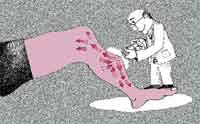Gene remedy
 patients with blocked blood vessels in their legs could soon be treated with the help of gene therapy. Jeffrey Isner and his colleagues at St Elizabeth's Hospital and the Tufts University School of Medicine near Boston, usa, report that patients would be able to grow their own bypasses after the therapy.
patients with blocked blood vessels in their legs could soon be treated with the help of gene therapy. Jeffrey Isner and his colleagues at St Elizabeth's Hospital and the Tufts University School of Medicine near Boston, usa, report that patients would be able to grow their own bypasses after the therapy.
During the study, the researchers injected genes into legs, eliciting the growth of a web of hairlike blood vessels that re-routed blood around the blockages. The blood flow improved remarkably. Out of 10 patients on whom the therapy was performed, three patients who had been scheduled for amputations avoided them entirely. For six patients, severe and unrelenting pain reduced significantly. However, one patient failed to respond to the therapy.
According to some experts, the study is a rare demonstration of clinical benefit from gene therapy and might be pivotal. There is no effective medicine for treating those patients who suffer from the disease. The researchers exploited the remarkable properties of a gene known as the vascular endothelial growth factor (veg f ), that is thought to be the body's signal to grow new blood vessels.
The aim of the researchers was to inject veg f genes directly into muscle cells near the blockage and allow the muscles to take up the gene and use it for making veg f protein. Nearly five per cent of the billions of genes that were injected, went into muscle cells and were used by them.
After injecting the genes, the muscle cells secreted the protein that made its way to nearby blood vessels. Normally, veg f does not attach itself to cells that line the blood vessel walls. But when a vessel is blocked, the cells just beyond the blockage that are starved for blood, become sticky to veg f . Thus the veg f proteins attach themselves to the exact sections of the blood vessels where they are required.
Once veg f sticks to their surfaces, the cells start to sprout a network of thread-like blood vessels. Then the new vessels wind their way around the blockage and form an alternative pathway for blood. And those genes which are not used in the process, are swept away by the blood stream and degraded.
Related Content
- Metagenomic and functional analyses of the consequences of reduction of bacterial diversity on soil functions and bioremediation in diesel-contaminated microcosms
- Isolation and characterization of three and four ring PAHs degrading bacteria from contaminated sites, Ankleshwar, Gujarat, India
- Bangladesh State of the Environment Report : The Monthly Overview, September 2013
- Metagenomic analysis of the bioremediation of diesel-contaminated Canadian high Arctic soils
- GFP expressing bacterial biosensor to measure lead contamination in aquatic environment
- Thalassemia patients might need fewer blood transfusions
